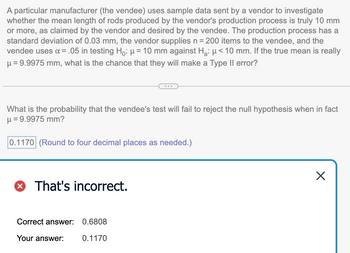A particular manufacturer (the vendee) uses sample data sent by a vendor to investigate whether the mean length of rods produced by the vendor's production process is truly 10 mm or more, as claimed by the vendor and desired by the vendee. The production process has a standard deviation of 0.03 mm, the vendor supplies n = 200 items to the vendee, and the vendee uses α = .05 in testing Ho: μ = 10 mm against H₂: µ< 10 mm. If the true mean is really μ = 9.9975 mm, what is the chance that they will make a Type II error? What is the probability that the vendee's test will fail to reject the null hypothesis when in fact μ = 9.9975 mm? (Round to four decimal places as needed.)
A particular manufacturer (the vendee) uses sample data sent by a vendor to investigate whether the mean length of rods produced by the vendor's production process is truly 10 mm or more, as claimed by the vendor and desired by the vendee. The production process has a standard deviation of 0.03 mm, the vendor supplies n = 200 items to the vendee, and the vendee uses α = .05 in testing Ho: μ = 10 mm against H₂: µ< 10 mm. If the true mean is really μ = 9.9975 mm, what is the chance that they will make a Type II error? What is the probability that the vendee's test will fail to reject the null hypothesis when in fact μ = 9.9975 mm? (Round to four decimal places as needed.)
A First Course in Probability (10th Edition)
10th Edition
ISBN:9780134753119
Author:Sheldon Ross
Publisher:Sheldon Ross
Chapter1: Combinatorial Analysis
Section: Chapter Questions
Problem 1.1P: a. How many different 7-place license plates are possible if the first 2 places are for letters and...
Related questions
Question
0.1190 is wrong could you please kindly reattempt this?

Transcribed Image Text:A particular manufacturer (the vendee) uses sample data sent by a vendor to investigate whether the mean length of
rods produced by the vendor's production process is truly 10 mm or more, as claimed by the vendor and desired by the
vendee. The production process has a standard deviation of 0.03 mm, the vendor supplies n = 200 items to the vendee,
and the vendee uses α = .05 in testing Hỏ: µ = 10 mm against H₂: µ< 10 mm. If the true mean is really μ = 9.9975 mm,
what is the chance that they will make a Type Il error?
What is the probability that the vendee's test will fail to reject the null hypothesis when in fact μ = 9.9975 mm?
(Round to four decimal places as needed.)
Expert Solution
This question has been solved!
Explore an expertly crafted, step-by-step solution for a thorough understanding of key concepts.
This is a popular solution!
Trending now
This is a popular solution!
Step by step
Solved in 2 steps

Follow-up Questions
Read through expert solutions to related follow-up questions below.
Follow-up Question
The answer is wrong. Please explain how they got 0.6808.

Transcribed Image Text:A particular manufacturer (the vendee) uses sample data sent by a vendor to investigate
whether the mean length of rods produced by the vendor's production process is truly 10 mm
or more, as claimed by the vendor and desired by the vendee. The production process has a
standard deviation of 0.03 mm, the vendor supplies n = 200 items to the vendee, and the
vendee uses α = .05 in testing Ho: μ = 10 mm against H₂: μ< 10 mm. If the true mean is really
μ = 9.9975 mm, what is the chance that they will make a Type II error?
What is the probability that the vendee's test will fail to reject the null hypothesis when in fact
μ = 9.9975 mm?
0.1170 (Round to four decimal places as needed.)
That's incorrect.
Correct answer: 0.6808
Your answer:
0.1170
X
Solution
Recommended textbooks for you

A First Course in Probability (10th Edition)
Probability
ISBN:
9780134753119
Author:
Sheldon Ross
Publisher:
PEARSON


A First Course in Probability (10th Edition)
Probability
ISBN:
9780134753119
Author:
Sheldon Ross
Publisher:
PEARSON
